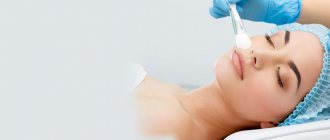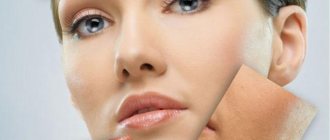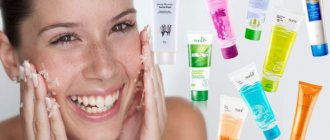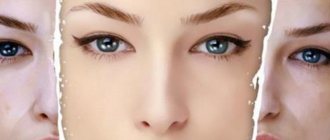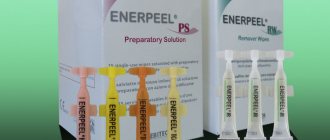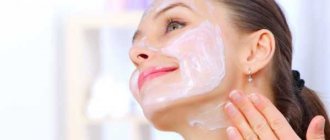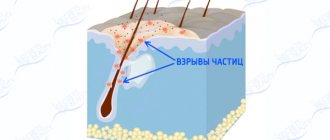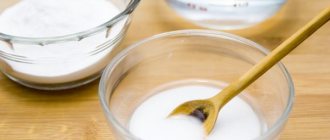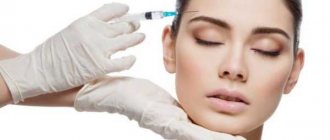The cosmetologist specializes in chemical peeling procedures for the face, neck, décolleté, hands and body.
It is used in complex programs for skin rejuvenation, as well as in the correction of pigment disorders and the treatment of acne.
We offer patients more than 50 types of different chemical peels: milk, almond, glycolic, pyruvic, Jessner, Hollywood, salicylic, retinoic (retinol or “yellow”), ferulic, trichloroacetic TCA and others.
Prices for the procedure
There is a promotion in the cosmetology department: any MCP superficial peeling – only 2200 rubles! Follow the updates on our website.
We use the following lines of chemical peels: MediDerma (SESDERMA), MediControlPeel, ENERPEEL, NATINUEL.
- CHEMICAL PEELINGS ENERPEEL
- SUPERFICIAL, SUPERFICIAL-MEDIUM PEELINGS
- MEDIUM, MEDIUM-DEEP PEELINGS
CHEMICAL PEELINGS ENERPEEL
| Name of service | price, rub. | Promotion! |
| Salicylic peeling ENERPEEL SA | 3000 rub. | — |
| Glycolic peeling ENERPEEL GA 70% | 3000 rub. | — |
| Almond peeling ENERPEEL MA | 3000 rub. | |
| Peeling for neck and back ENERPEEL SA-CB | 4200 rub. | — |
| Jessner Peel ENERPEEL JR (salicylic acid 15%, lactic acid 20%, resorcinol 15%) | 4000 rub. | — |
| Peeling TCA ENERPEEL (trichloroacetic acid 25%) | 4500 rub. | — |
| Peeling TCA ENERPEEL STRONG (trichloroacetic acid 40%) | 5500 rub. | — |
| Pyruvic peeling ENERPEEL PA 50% | 3200 rub. | — |
SUPERFICIAL, SURFACE-MEDIUM PEELINGS:
| Name of service | price, rub. | Promotion! |
| Chemical superficial peeling MediControlPeel (pyruvic, milky, salicylic, glycolic, almond) | 2200 rub. | — |
| Almond peeling NATINUEL | 2700 rub. | 2300 rub. |
| Glycolic peeling NATINUEL | 2500 rub. | |
| Glycolic peeling MEDIDERMA | 2500 rub. | |
| Glycolic peeling MCP | 2200 rub. | |
| Glycolic whitening peeling MCP | 2500 rub. | |
| Peeling "Anti Acne" ACNE STOP NATINUEL | 3500 rub. | — |
| Milk peeling MEDIDERMA with DMAE | 3000 rub. | — |
| Almond peeling with DMAE Simildiet | 2300 rub. | — |
| Almond peeling MEDIDERMA | 2500 rub. | — |
| Almond peeling MCP | 2200 rub. | |
| Salicylic peel MCP | 2200 rub. | |
| Salicylic peeling MEDIDERMA | 2500 rub. | |
| Azelaine peeling Simildiet | 2100 rub. | — |
| Azelaine peeling MEDIDERMA | 2500 rub. | — |
| MEDIDERMA pyruvic peeling | 3000 rub. | |
| Superficial Jessner peel MCP (1 layer) | 2200 rub. | — |
| Coral peeling Rose-de-Mer Christina | 3500 rub. |
MEDIUM, MEDIUM-DEEP PEELINGS:
| Name of service | price, rub. | Promotion! |
| Jessner peeling MCP classic medium | 3100 rub. | — |
| Jessner peeling MEDIDERMA | 3500 rub. | — |
| Jessner peeling modified MEDIDERMA | 3500 rub. | — |
| Yellow peeling Yellow Peels Kosmoteros | 3500 rub. | — |
| Yellow peeling MEDIDERMA Retises CT | 4500 rub. | HIT! |
| Yellow intensive peeling MEDIDERMA Retises Forte | 5000 rub. | — |
| Yellow peeling MCP | 4000 rub. | — |
| Yellow MCP peeling (face, neck, décolleté) | 5000 rub. | |
| Peeling trichloroacetic TCA 10%, 25%, 30%, 40% | from 3200 rub. | — |
| Ferul peeling | 5500 rub. | — |
| Applying retinol cream 1% - 10% | from 1000 rub. | — |
What is a chemical peel?
Chemical peeling or exfoliation is a doctor-controlled burn of the skin to achieve the desired cosmetic effect after recovery.
The procedure is primarily aimed at exfoliating the top layer of skin cells. Its purpose is to smooth and cleanse the surface of the epidermis, as well as facilitate access to fresh, young, moisture-rich cells, giving the skin a radiant and fresh appearance.
Peeling can be carried out using completely different methods - for example, there are procedures using ultrasound, laser, acid, enzymes, mechanical dermabrasion, etc.
How peeling works
Peeling procedures weaken intercellular connections, and dead skin cells are easily separated. It’s as if a dull, cloudy film is being removed from the face, under which satiny, radiant skin was hiding. Small wrinkles disappear, pores are cleaned, and the overall skin tone is evened out. Peeling also helps get rid of unwanted pigmentation, post-acne, and scars.
Peeling increases skin hydration and also stimulates collagen synthesis in it. It is no secret that with age, the destruction of collagen in the skin begins to prevail over synthesis, which is why the skin loses its elasticity and density. Regular chemical peeling helps restore the collagen framework, literally turning back time.
Indications
Mechanical and chemical peelings are very effective procedures in cases where the skin of the face is oily, problematic, and seborrhea is observed. It is also effective on skin with signs of photoaging, without severe sagging and stretching.
Peeling is mainly done on the face, but it can also be used on other parts of the body: arms, hips, neck, décolleté, abdomen, etc.
Dermatologists around the world have officially adopted the chemical method as one of the main procedures for treating acne in their patients. It is no secret that teenagers most often suffer from this disease, and this type of skin renewal can be successfully used to heal them.
It is believed that this procedure is designed to solve exclusively aesthetic problems, but this opinion is completely wrong. Today, peeling is successfully used to treat many skin diseases, such as acne, papillomas, dyschromia, etc. It also allows you to effectively cleanse the skin of dead particles, stimulate cells to work actively, improve complexion and remove age spots, get rid of wrinkles and “ crow’s feet”, normalize the functioning of the sebaceous glands and generally help patients look fresher and more attractive.
Reviews of facial peelings in the salon
In most cases, reviews of facial peeling in a salon contain positive information.
For the convenience of readers, descriptions of different types of procedures with client comments are provided.
Mechanical facial cleansing
This group includes 3 types of exposure.
- Brossage involves easy cleansing using a special device equipped with natural bristle brushes. The procedure begins with steaming the skin, applying a scrub, and then the dermis is exposed to rotating brushes. Duration is 10 minutes. As a result, blood circulation improves and the skin is renewed.
- Deeper removal of epidermal cells occurs during microdermabrasion. Thanks to special equipment, the skin is polished with aluminum dioxide particles or diamond dust under local anesthesia. This technique helps eliminate the effects of acne, shallow wrinkles, and scars. Negative consequences are very rare, and the effect is visible almost immediately.
- In case of serious problems: large scars, deep wrinkles, severe pigmentation, scars, brushes of increased rigidity are used, which rotate at high speed. Painful sensations are neutralized with local or general anesthesia. The procedure can last from several minutes to 1 hour depending on the area of problem areas.
As confirmation, below are reviews of facial peeling from different clients from a cosmetologist.
Svetlana, 22 years old, student.
I tried the brossage to cleanse the skin. After several procedures, the condition of the epidermis noticeably improved. The appearance of acne has become less visible and the fresh color has returned.
Alla, 41 years old, cosmetologist.
I practice leveling the epidermis using the most gentle method. It is practically safe and allows up to three sessions per month. I believe that regularity can delay skin aging for a long time.
Irina, 53 years old, chemical engineer.
The problems require serious action, but chemicals are not suitable for this, probably due to the specifics of the work. The doctor recommended cleansing with aluminum oxide, and she was pleased with the results.
Chemical peeling
In this case, aggressive liquids are used to burn the dermis, the degree of which is strictly controlled and depends on the concentration of the active substance.
- Superficial treatment affects only dead cells; at the same time, collagen formation is enhanced. This increases the firmness and elasticity of the skin.
- The median effect is carried out by trichloroacetic acid. It is recommended for weak age spots and fine wrinkles. To achieve a visible effect, at least three procedures are required.
- The most aggressive method is treatment with phenolic mixtures in a hospital setting. The result is that the face becomes crusty; it will take up to six months for the skin to recover.
The advantages of chemical peeling in the salon are characterized by customer reviews.
Liliya, 48 years old, teacher.
My line of work always requires me to look perfect. The salon offered to even out my complexion and remove wrinkles using chemical peeling. After several procedures, pigmentation almost disappeared and the skin smoothed out.
Dasha, 29 years old, cosmetologist.
Chemical peeling is the ideal choice to slow down the onset of age-related changes, remove freckles and other types of pigmentation, and cope with acne. I use it myself and recommend it to clients with similar problems.
Christina, 31 years old, doctor.
I think it is important to choose a competent specialist. This approach will provide half the success. That’s what I did and monitored reviews of salon peeling in my city. Thanks to the procedure, I achieved the effect of skin rejuvenation.
Fruit peeling
This type of exposure combines high efficiency and safety. The active ingredients are fruit acids. They not only remove dead skin cells well, but also help treat inflammation of various types, rejuvenate the skin, and remove toxins. A soft, velvety surface of the epidermis and a fresh tone will be the result of the effort expended.
Here are a few reviews about facial peeling in the salon
Alina is 15 years old, a schoolgirl.
Adolescence brought with it skin problems that could not be eliminated using traditional methods. After much suffering, I tried a low-concentration glycolic peel. The effect exceeded our wildest expectations, but you will need to complete a course of sessions to achieve a lasting effect.
Victoria, 37 years old, cosmetologist.
As a specialist, I am well acquainted with the specific features of each type of peeling. For myself, I prefer treatment with glycolic acid. It gently cleanses the skin without thinning it, evens out the surface and tone. From my own experience, I can say that women mostly leave positive reviews about salon facial peeling and try to repeat the procedure.
Evgeniya, 31 years old salesperson.
I discovered fruit peeling. Fine wrinkles disappeared, the skin tightened, and the functioning of the sebaceous glands normalized. I noticed that after the procedures, masks and creams work more effectively. Redness appeared in some places, which disappeared after 2 days. It is important not to exfoliate the skin in the summer to avoid exposure to ultraviolet radiation.
Physical method of peeling
This type includes 2 cleaning options.
- The ultrasound method is based on the penetration of waves of a certain length into the deep layers of the skin. This helps to increase the flow of lymph and blood and reduce the appearance of swelling.
- The laser procedure requires performing in a hospital setting under anesthesia.
Below are reviews about the effectiveness of facial peeling using physical methods.
Anna, 29 years old, manager.
I especially liked the ultrasonic cleaning; I was pleased with the lack of painful sensations. After the procedure, the pores were cleaned, wrinkles were reduced, and the tone was evened out.
Alena, 35 years old, architect.
I felt pain during the session, but for oily skin with enlarged pores, the laser is an ideal option. The new look gave me back my self-confidence, and I don’t mind spending the money for it.
Anastasia, 27 years old teacher.
Laser peeling does not injure the epidermis as much; I only have scabs in problem areas, and after they disappear, the skin is simply in perfect condition.
Varieties
Depending on the degree of exposure and penetration level of acids, 3 types of peeling can be distinguished:
- surface;
- median;
- deep.
Superficial peeling using acids does not affect living cells and leads to cleansing and exfoliation of the epidermis (its surface layers or completely, exposing the papillary layer of the dermis). The technique makes it possible to cleanse the skin of makeup residues and impurities with maximum efficiency. That is why most cosmetologists begin any cosmetic procedure with it.
Medium-impact chemical peeling is actually a programmed chemical burn of the skin that destroys living cells of the epidermis, followed by its detachment (detachment can expose the upper part of the mesh layer).
For deep exposure, formulations containing phenol (and sometimes also croton oil) are used, causing destruction of the epidermis and upper layers of the dermis. As a result, the epidermis is exfoliated as much as possible down to the middle of the reticular layer of the dermis. Phenol peeling allows you to eliminate deep wrinkles on the face and remove atrophic scars. At the same time, the facial skin is stretched tightly, you can observe the effect of its tightening, which sometimes lasts for 5-8 years.
The type of peeling is determined depending on the composition of the products used. So, for superficial procedures, as a rule, alpha hydroxy acids are used. These are lactic, glycolic, grape or malic acid, salicylic or mandelic acid. The technique allows you to significantly weaken intercellular connections, due to which the skin is smoothed and effectively exfoliated. In this procedure, specialists use exclusively low-concentrated acid solutions. This type of exposure is optimal in cases where the defects present on the skin are slightly expressed.
Medium (medium) peeling has a deeper effect. Thanks to it, the cells become more active, and the skin is “damaged” to a greater depth. At the same time, the cells begin to intensively produce collagen and elastin, on which the elasticity and tone of the epidermis depends. This technique makes it possible to get rid of the first age-related changes, small skin defects and age spots.
The most serious and painful type is the deep type of chemical peeling, in which the skin is damaged down to the papillary layer. This procedure is carried out exclusively under anesthesia in a hospital setting; it is equivalent to a surgical operation.
This method is usually chosen based on the patient's skin characteristics.
Pumpkin peeling for oily skin
Zilya Fayzullina Beauty editor, 27 years old
Skin type : oily
Problem : local inflammation in the chin area, oily shine, enlarged pores
Desired result : even complexion, elimination of blackheads and acne marks
Cosmetologist's solution : pumpkin (royal) peeling
Description : Pumpkin peeling is a new direction in skin cleansing. It not only gently cleanses the surface of the face, but also strengthens cells, replenishes the lack of mineral components, and improves the condition and tone of the skin. Pumpkin also contains a large amount of fatty acids. They soften the epidermis, increase its protection against moisture loss and external factors. Despite its delicate composition, the peeling effectively removes acne spots and tightens pores.
Review : “I love peelings and do them in courses every year. I think I've tried everything from retinoic to Jessner. Perhaps that is why the result did not impress me. Yes, the face began to look fresher, a velvety appearance appeared. But I get the same effect after any salon treatment without the use of acids. Considering that my skin gets oily at times, my option is medium peels. Even with a rehabilitation period. And when preparing for a long-awaited date, I would prefer the Hydra Facial procedure to pumpkin peeling.”
Rating : 6 out of 10.
Recently, all-season peels for all skin types have been gaining popularity.
Ekaterina Bystrova Medical cosmetologist, winner of the All-Russian championship of cosmetologists “The Shining of Baikal”
The consequences of their use are almost invisible, while they perfectly stimulate fibroblasts, help the skin produce elastic collagen, elastin and hyaluronic acid.
All-season superficial peeling is good for refreshing the skin, but deep wrinkles will need to be smoothed out with serious medium peelings. They are quite aggressive and require training and rehabilitation! To minimize complications, such procedures are carried out in winter.
Chemical peel procedure and results
The essence of peeling is to apply a special composition to the skin of the patient’s body or face, which allows you to create a mild chemical burn on it. At the same time, the aggressive composition frees the deep layers from dead cells, “burning” the upper, very thin part. Fresh, renewed, healthy skin appears in place of “burnt” cells.
For medium and deep peels, pre-peeling preparation is required. Its duration is from 2 to 8 weeks. It can combine both the use of weakly acidic bleaching solutions and the intake of antioxidant drugs orally. This set of procedures evens out the thickness of the stratum corneum, and acid preparations penetrate the skin more evenly. This reduces the risk of excessive pigmentation in the future.
It is recommended to stop using external retinoids (Retin-A) 1 week before peeling, and internal retinoids (Roaccutane) 6 months before, as they enhance the process of skin exfoliation. It is also necessary to stop traumatic cosmetic procedures such as hair removal 1 week in advance, and mechanical and laser resurfacing 6 months in advance.
Before peeling, the skin is thoroughly cleaned and degreased to ensure more uniform penetration of the drug. Areas that will not be exposed to the drug are protected with Vaseline, gauze pads, etc. Within 30 seconds, the drug is applied in the sequence: forehead - cheeks - chin - nose. The exposure time of the drug is individual and depends on the skin reaction, the patient’s subjective feelings and other factors, but, as a rule, it lasts from 0.5 to 5 minutes.
After this, the acidic composition is usually neutralized with alkali (optional, depending on the drug) and the skin is washed, dried and cooled.
The total duration of the procedure is from 20 minutes to 2 hours.
The best time for medium and deep peels is autumn and winter, to avoid exposure of the skin to active sunlight.
The procedure is not only capable of exfoliating dead cells. In addition, it evens out and brightens the surface of the skin, removes unevenness, scars, acne, age spots, excess skin around the eyes, bags, fine and deep wrinkles.
Deep peels are designed to solve very serious problems, eliminating age-related changes and defects on the skin of the face, neck and hands. As a result of this, turgor improves, its elasticity increases and it is completely renewed.
Possible complications after facial cleansing
The longer the solution remains on the skin, the higher the likelihood of complications. Therefore, it is very important to select the duration of exposure of the mask on the face for each type of skin, taking into account its sensitivity and characteristics. Despite the high skill of specialists and compliance with all rules, the frequency of complications remains quite high:
- the appearance of allergic reactions;
- chemical burn to the face;
- arrhythmia;
- development of acute renal, liver or heart failure;
- increased risk of developing skin cancer;
- development of purulent complications;
- the appearance of a clear line dividing the skin unaffected by the procedure and the newly grown dermis deprived of new grown dermis as a result of deep peeling of melanocytes;
- the appearance of scars due to the destruction of cells of the basal layer of the epidermis;
- increased pigmentation (especially for patients with dark skin);
- hyperkeratosis;
- increase in the number of spider veins.
Complications and side effects can also occur in completely healthy people, since the permeability of the skin is different for each person. Accordingly, the concentration of phenol in the blood after deep peeling can be exceeded due to increased penetration through the skin.
Contraindications and side effects
Contraindications include the following:
- infectious diseases,
- exacerbation of skin diseases,
- neoplasms,
- warts,
- pathology of the thyroid gland,
- skin damage,
- herpes in active form,
- allergies and hypersensitivity,
- tendency to form keloid scars,
- taking Roaccutane no earlier than 6 months. before the procedure,
- pregnancy and lactation,
- childhood.
Side effects may include hyperpigmentation, swelling, redness, blistering and itching.
In rare cases, more serious complications occur: persistent swelling (more than 48 hours), persistent redness of the skin, hyperkeratosis, atrophic changes in the skin, milia, scars, the appearance of a visible border of the areas subjected to peeling.
To reduce the risk of side effects, the procedure must be performed in a licensed cosmetology center, with highly qualified and experienced specialists.
By clicking “Submit”, you consent to the processing of your personal data in accordance with Federal Law No. 152-FZ “On Personal Data” and accept the terms of the User Agreement
Photos BEFORE and AFTER peeling
Skin phototypes: Fitzpatrick classification
There is a Fitzpatrick skin classification that describes the degree of skin pigmentation and tanning ability. This classification divides the skin according to risk factors for complications of chemical peeling. Fitzpatrick identifies six skin types, taking into account both skin color and reaction to the sun:
- Type I
Celtic Skin is delicate, milky white, often with freckles, red or very blond hair and blue or green eyes. The formation of melanin in the skin is insignificant, sunburn is possible, the tan practically does not last (more often residents of Ireland, Scandinavia, Scotland. Example: Renee Zellweger, Nicole Kidman) - Type II
Light European Typical blondes. The skin is fair, with few or no freckles. The hair is light brown, from light brown to gray brown. Eyes blue, gray, greenish. The tan does not apply well, leaving a slight golden tint (approximately 70% of the European population. Example: Marilyn Monroe, Charlize Theron) - III type.
Dark European Skin color varies seasonally. In winter, the skin is light and has a high contrast with the hair. In the summer, when tanning, the contrast between the skin and hair decreases sharply, and the skin acquires a dark tint. Hair ranges from medium brown to dark brown, medium brown to dark brown. Eyes from light brown to dark brown, gray-green, dark green (population of Kazakhstan, Central Asia. Example: Natalie Portman, Audrey Hepburn) - IV type.
Mediterranean, or Southern European Skin dark olive. Hair ranges from dark brown to dark chocolate color. The eyes are rich brown shades, the iris contrasts sharply with the bluish white of the eyes. Skin of this type quickly acquires an even bronze tan (representatives of Armenia, Italy. Example: Monica Bellucci, Salma Hayek) - V type
Indonesian, or Middle Eastern Skin is very complex with a yellow tint. Hair ranges from dark brown to black. Eyes are rich brown, closer to black (residents of China, India, Korea. Example: Lucy Liu, Nicole Scherzinger) - VI type.
African Americans Skin is very dark (ethnic). Hair and eyes are as dark as possible. This type has the highest level of melanin (indigenous population of the African continent. Example: Beyoncé, Naomi Campbell)
For our region, phototypes I to IV are most relevant.
Patients with skin types I and II and significant degrees of photodamage require constant sun protection before and after the chemical peel procedure. However, the risk of developing hypopigmentation or hyperpigmentation in these individuals is quite low. Patients with skin types III and IV after chemical peels are at greater risk of pigmentary dyschromia - hyper- or hypopigmentation - and may require pre- and post-application of not only a sunscreen, but also a bleaching agent to prevent these complications. The risk of pigmentation disturbance is not too great after a very superficial or superficial peel, but it can become a significant problem after a medium or deep chemical peel.

